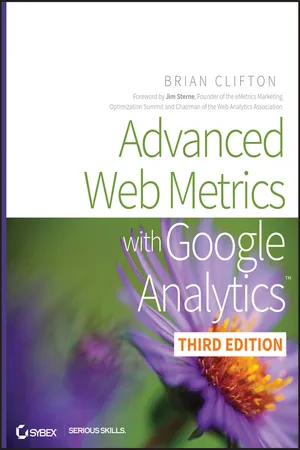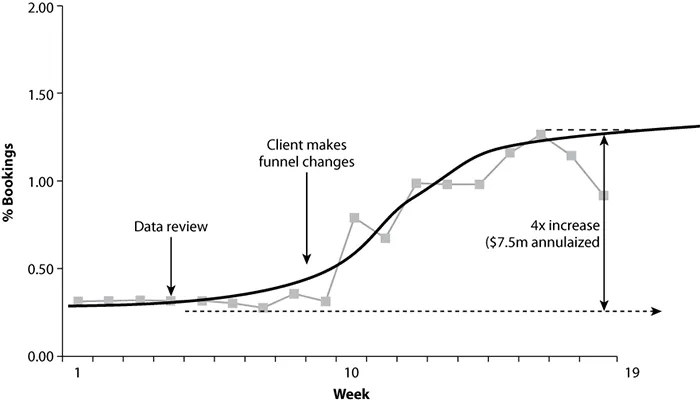![]()
Part I
Measuring Success
Lord Kelvin is often quoted on the reason metrics are so important: “If you cannot measure it, you cannot improve it.” That statement is ultimately the rationale for web analytics. By enabling you to identify what works and what doesn’t from a visitor’s point of view, web analytics is the foundation for running a successful website. Even if you get those wrong, web analytics provides the feedback mechanism that enables you to identify mistakes quickly.
In Part I, you will learn the following:
Chapter 1 Why Understanding Your Web Traffic Is Important to Your Business
Chapter 2 Available Methodologies and Their Accuracy
Chapter 3 Google Analytics Features, Benefits, and Limitations
![]()
Chapter 1
Why Understanding Your Web Traffic Is Important to Your Business
Web analytics is a thermometer for your website, constantly checking and monitoring your online health. As a methodology, it is the study of online experience in order to improve it; without it, you are flying blind. How else would you determine whether your search engine marketing is effective, or even sufficient, for capturing your potential audience or whether your investment in creating a social media buzz has been worth it? Is the visitor experience a good one, encouraging engagement, repeat visits, and sales, or are visitors bouncing off your website after viewing only a single page?
In Chapter 1, you will learn:
- The kinds of information you can obtain from analyzing traffic on your site
- The kinds of decisions that web analytics can help you make
- The ROI of web analytics
- How web analytics helps you understand your web traffic
- Where web analytics fits into your organization
Website Measurement—Why Do This?
It’s an obvious question and one that has an obvious answer—as provided by the 19th century scientist Lord Kelvin and included in the introduction to Part I. The idea of applying a measurement tool to assess a website’s effectiveness is an easy sell. Every business owner or executive understands the importance of measurement. But there’s another question that comes up at initial meetings within an organization where website performance is being discussed: Why do we need another measurement tool in our business?
The most common fear is data overload—collecting more information, just because you can, inevitably leads to more confusion, not clarity. This is particularly the case when your website is operating as a silo, that is, not integrated with the rest of your business—a common problem if yours is a nontransactional website. Therefore, an important early step when deciding on a website measurement strategy is to define the value that web measurement can bring to your business. You can achieve this whether yours is a transactional site or not (see “Monetizing a Non-E-Commerce Website,” in Chapter 11, “Real-World Tasks”), though here I illustrate value using transactional examples because these are easier to grasp in the first instance.
Figure 1-1 shows the improvement a travel website gained by optimizing its online booking process—that is, the steps a visitor takes in order to book a chosen vacation. (In Google Analytics terminology, the booking process steps are referred to as a funnel—directly analogous to any sales funnel in your organization.)
As you can see, the changes to the booking process took several weeks to implement (the client was not confident enough to take on board all the recommendations at once), but the cumulative impact was dramatic—a 383 percent increase in its booking conversion rate. Put in monetary terms, this equated to an annualized increase in revenue of $7.5 million.
The second example of the value of web measurement is shown in Figure 1-2. In this case, a measurement tool was able to quickly identify problems following the launch of a new site redesign. Essentially, server redirects were incorrectly assigned in the new site, resulting in a 48 percent loss of search engine traffic and a 21 percent loss in sales revenue. Following the identification of the problem, the client’s visitor and revenue numbers were back to previous levels within four weeks.
If your website is an important part of your business strategy, then website measurement is also important to that strategy. The magnitudes of each are strongly correlated—that is, the more you spend (or earn) from your website, the greater the need for solid, reliable data from your web measurement tools. Such tools can be used to identify growth opportunities, measure efficiency improvements, and highlight when things go wrong.
Some people will say, “We are only interested in visitors who convert,” that is, become a customer, “and not the rest of the reports,” but that is misguided thinking. The conversion rate—the proportion of visitors that build a relationship with you (download a brochure or fact sheet, for example) or become a customer directly—is usually only 1 to 3 percent of your total visitor traffic (see Figure 1-4 later in this chapter). While this is clearly a valuable segment of your current business, the other 97-plus percent represents the greatest potential for future improvement.
Conversely, I also hear, “We already track brochure downloads (or e-commerce transactions) in our customer relationship management (CRM system), so we don’t need that feature in our web analytics tool.” But can your CRM system tell you what marketing campaigns, search engine keywords, or referral links drove visitors to your site in the first place? Perhaps there were multiple campaigns and referrals involved, including email and social links on Facebook, Twitter, and so forth. Can your CRM system tell you which customers are easier—cheaper—to acquire and rank them accordingly? Or is it able to provide information on which parts of your content are most relevant to your customers? To be honest, I have yet to discover a CRM system that comes even remotely close to closing the loop on customer acquisition, unless it is integrated with a web analytics tool.
Glossary of Terms
At this stage it would be useful for you to be familiar with some of the terminology used in Google Analytics. The following is a short summary. A more complete list can be found at the following location:
http://support.google.com/analytics/bin/answer.py?hl=en&answer=1033060
Bounced visitor A visitor who views only a single page on your website and has no further actions. This is generally considered a bad experience.
Campaign The name of a specific campaign, for example, book sales (for a paid search campaign), spring sale (for a banner campaign), January newsletter (for an email shot), Facebook offer (for a social media promotion).
Google Analytics Tracking Code (GATC) This snippet of code must be added to every page on your website to enable Google Analytics to collect and report on visit data. Also more generally referred to as the page tag.
Goal conversion Often abbreviated to just goal or conversion, this is a desired page or action on your website that is defined as being more valuable than a standard pageview. For example, a “purchase confirmation” page (visitor becomes a customer), a “thank you for registering” page (visitor becomes a prospect), a file download or “click to play video” page (visitor is engaged).
Funnel A well-defined process (most usually pages) leading to a conversion goal, such as, for example, using a check-out system.
Landing page The first page visitors arrive on when they visit your website. Also known as the entrance page.
Medium In the context of campaign tracking, medium indicates the channel by which a visitor to your site received the link to you, such as, for example, “organic” and “cost-per-click” for search engine links, “email” and “PDF” in the case of newsletters, “referral” for sites that link to you, and “direct” for a visitor who types your web address directly into their browser.
Referrer The URL of an HTML page that refers visitors to a site. That is, the external page from which visitors come to your website.
Return on investment (ROI) Calculated as (revenue – cost) / cost and displayed as a percentage.
Session Also referred to as a visit or visitor session, this is the measured period of interaction a visitor has with your website. A session starts when a visitor views the first page of your website and ends when one of the following three conditions is met as defined by Google Analytics: 30 minutes has elapsed without visitor activity; the session has reached the end of the day (for the time zone defined in Google Analytics); or the same visitor returns to the website but with new referral parameters. For example, a visitor first arrives at your website via an organic search, closes their browser, then returns (within 30 minutes) via a click on a banner link. The detection of the second visit with the new campaign parameters closes the first session and begins a new one for this visitor. The session time-out value can be adjusted (see Chapter 7, “Advanced Implem...


